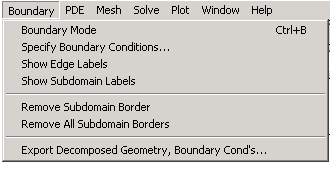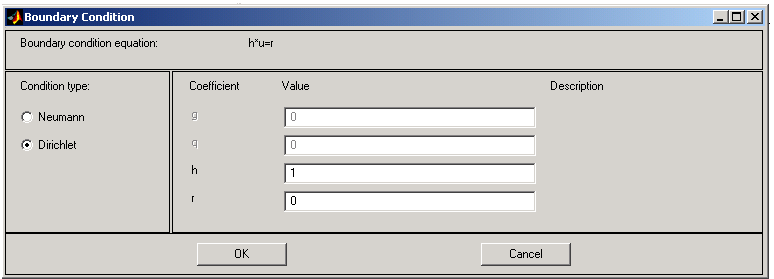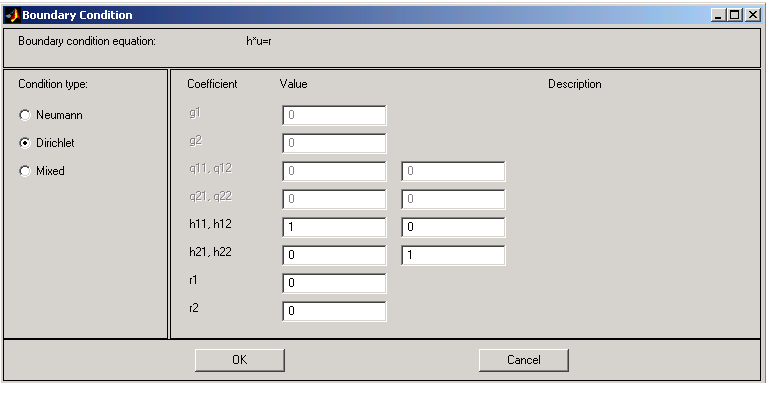| Partial Differential Equation Toolbox |
  |
Boundary Menu

Boundary Mode
|
Enter the boundary mode.
|
Specify Boundary Conditions . . .
|
Specify boundary conditions for the selected boundaries. If no boundaries are selected, the entered boundary condition applies to all boundaries.
|
Show Edge Labels
|
Toggle the labeling of the edges (outer boundaries and subdomain borders) on/off. The edges are labeled using the column number in the Decomposed Geometry matrix.
|
Show Subdomains
Labels
|
Toggle the labeling of the subdomains on/off. The subdomains are labeled using the subdomain numbering in the Decomposed Geometry matrix.
|
Remove Subdomain Border
|
Remove selected subdomain borders.
|
Remove All Subdomain Borders
|
Remove all subdomain borders.
|
Export Decomposed Geometry, Boundary Cond's . . .
|
Export the Decomposed Geometry matrix g and the Boundary Condition matrix b to the main workspace.
|
Specify Boundary Conditions . . .

Specify boundary conditions . . . displays a dialog box in which you can specify the boundary condition for the selected boundary segments. There are three different condition types:
- Generalized Neumann conditions, where the boundary condition is determined by the coefficients
q and g according to the following equation:
- In the system cases,
q is a 2-by-2 matrix and g is a 2-by-1 vector.
- Dirichlet conditions: u is specified on the boundary. The boundary condition equation is hu = r, where h is a weight factor that can be applied (normally 1).
- In the system cases,
h is a 2-by-2 matrix and r is a 2-by-1 vector.
- Mixed boundary conditions (system cases only), which is a mix of Dirichlet and Neumann conditions.
q is a 2-by-2 matrix, g is a 2-by-1 vector, h is a 1-by-2 vector, and r is a scalar.
The following figure shows the boundary condition dialog box for the generic system PDE.

For boundary condition entries you can use the following variables in a valid MATLAB expression:
- The 2-D coordinates
x and y.
- A boundary segment parameter
s, proportional to arc length. s is 0 at the start of the boundary segment and increases to 1 along the boundary segment in the direction indicated by the arrow.
- The outward normal vector components
nx and ny. If you need the tangential vector, it can be expressed using nx and ny since tx = -ny and ty = nx.
- The solution
u.
- The time
t.
| Note
If the boundary condition is a function of the solution u, you must use the nonlinear solver. If the boundary condition is a function of the time t, you must choose a parabolic or hyperbolic PDE.
|
Examples: (100-80*s).*nx, and cos(x.^2)
In the nongeneric application modes, the Description column contains descriptions of the physical interpretation of the boundary condition parameters.
 | Draw Menu | | PDE Menu |  |






